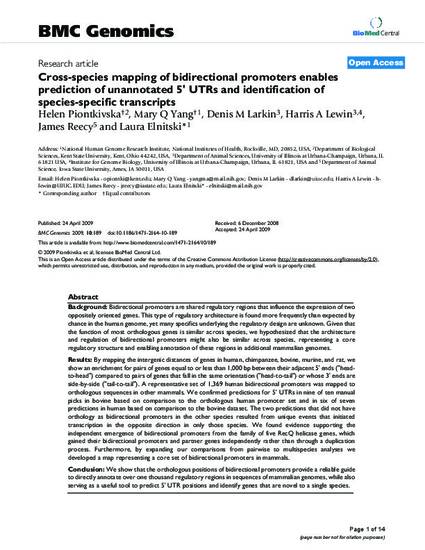
Bidirectional promoters are shared regulatory regions that influence the expression of two oppositely oriented genes. This type of regulatory architecture is found more frequently than expected by chance in the human genome, yet many specifics underlying the regulatory design are unknown. Given that the function of most orthologous genes is similar across species, we hypothesized that the architecture and regulation of bidirectional promoters might also be similar across species, representing a core regulatory structure and enabling annotation of these regions in additional mammalian genomes. By mapping the intergenic distances of genes in human, chimpanzee, bovine, murine, and rat, we show an enrichment for pairs of genes equal to or less than 1,000 bp between their adjacent 5' ends ("head-to-head") compared to pairs of genes that fall in the same orientation ("head-to-tail") or whose 3' ends are side-by-side ("tail-to-tail"). A representative set of 1,369 human bidirectional promoters was mapped to orthologous sequences in other mammals. We confirmed predictions for 5' UTRs in nine of ten manual picks in bovine based on comparison to the orthologous human promoter set and in six of seven predictions in human based on comparison to the bovine dataset. The two predictions that did not have orthology as bidirectional promoters in the other species resulted from unique events that initiated transcription in the opposite direction in only those species. We found evidence supporting the independent emergence of bidirectional promoters from the family of five RecQ helicase genes, which gained their bidirectional promoters and partner genes independently rather than through a duplication process. Furthermore, by expanding our comparisons from pairwise to multispecies analyses we developed a map representing a core set of bidirectional promoters in mammals. We show that the orthologous positions of bidirectional promoters provide a reliable guide to directly annotate over one thousand regulatory regions in sequences of mammalian genomes, while also serving as a useful tool to predict 5' UTR positions and identify genes that are novel to a single species.
Available at: http://works.bepress.com/james_reecy/57/

This article is from BMC Genomics 10 (2009): 189, doi:10.1186/1471-2164-10-189.